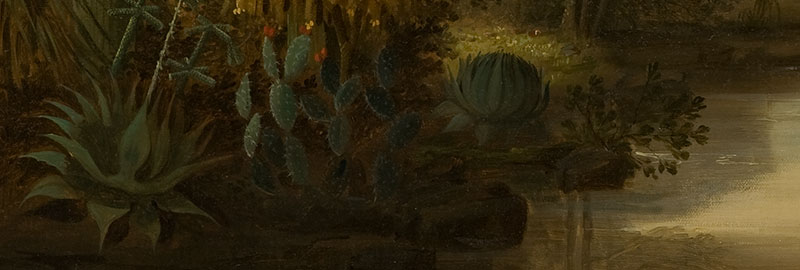Up Close and Personal: John Mix Stanley and Philip C. Curtis

Jun, 13, 2020
Art
Up Close and Personal: John Mix Stanley and Philip C. Curtis
In honor of our local heritage, the PhxArt collection includes a number of objects that reflect the dynamic beauty and unique flora of our desert home. Get up close and personal with Cole Larson-Whittaker, forthcoming PhD candidate and Abbott Fellow at Desert Botanical Gardens and Arizona State University, as he examines two paintings from our American art collection from the perspective of a botanist.
Chain of Spires Along the Gila River (1855) by John Mix Stanley
I love this painting. It’s beautiful and whimsical. You can see three species of cholla, two species of agave, one species of prickly pear, saguaro, and a species of sotol. For the trees, I see creosote and cottonwood, but there’s also something unexpected—I suspect the painting includes an early Southwest example of the tamarisk tree, marked by its blue-green hue, which was introduced from Eurasia in the mid to early 1800s and grows along river banks. This painting was created before many of these species were botanically described, which means it captures a unique moment in plant history.
If I’m looking at this from a purely botanical and ecological perspective, the scene has a quality of magical realism to it because it looks like it could be real and plausible, but a lot of these cactuses just don’t grow right alongside a river like this. Saguaro, agave, cholla, sotol, and even some of the trees are not riparian species, or species that grow next to water; rather they grow near water.

The scene also includes what looks like a pronghorn antelope. Though found in Arizona in huge numbers prior to European settlement, pronghorns—who in the mid 1800s numbered probably tens of millions and now only number about 10,000 in Arizona—are a mid-elevation species found primarily in the grasslands, not lowland Sonoran desert.

The inclusions of these flora, fauna, and geological formations in one scene transform this painting into a kind of long-exposure shot of Stanley’s entire time spent on the Gila River, as opposed to documenting a single location.

Philip C. Curtis, Dying Saguaro (Saguaro moribundo), 1958. Oil on panel. Bequest of Iris S. Darlington.
Dying Saguaro (1958) by Philip C. Curtis
You know you’re in the Sonoran desert when you see a saguaro. They aren’t found in any other deserts in the Southwest. It takes 30 to 40 years for a saguaro, an example of a columnar cactus, to reach flowering maturity and between 60 and 80 years for it to grow its first arm. After that, saguaros will grow arms at any given rate. Once they get to the point where they are growing arms, their main trunk stops flowering and only the arms will flower. Saguaros flower at the very tops of the arms and the main trunk and have evolved with bats as their primary pollinators.
Saguaros have a woody interior that isn’t wood but rather connective tissues used to transport and store liquids up and down the plant. The reason there are ridges, which you can see here in the structure of this painted saguaro, is that when it rains, the saguaro can expand.
The saguaro in this painting is dead, but there’s a little green growth at the top that seems to still be alive. This might seem impossible, but I’ve seen what look like dead saguaros in the desert and they still have a little green something they’ve sent up. This is an interesting moment depicting both life and death, and I can see why Philip C. Curtis would find this saguaro interesting to paint. Desert plants want to live, and they’ll do anything to do it.
Categories
What can we help you find?
Need further assistance?
Please call Visitor Services at 602.257.1880 or email